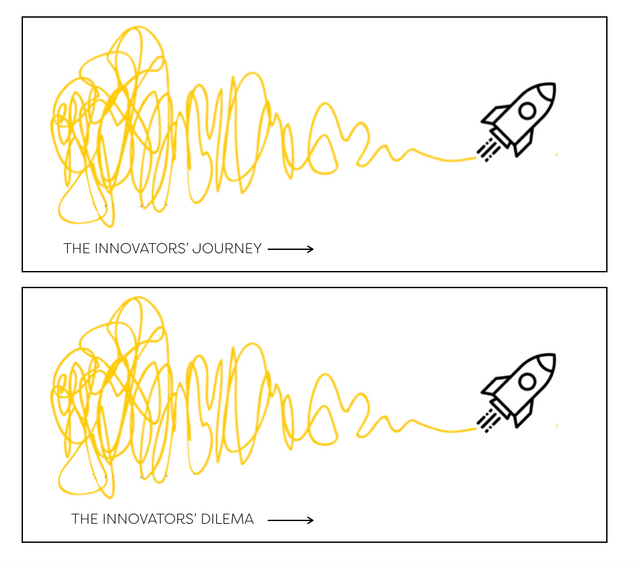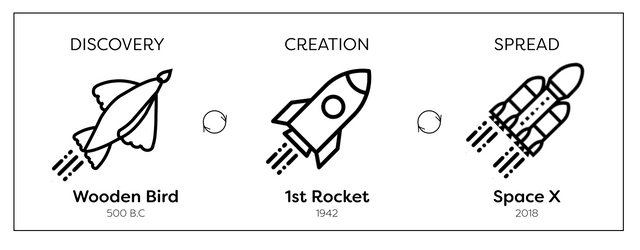
Much remains unknown; nothing stands unknowable
~ Carl Sagan
Carl Sagan was perhaps one of America’s most beloved scientific visionary since Albert Einstein. A pioneer in bridging the gap between scientists and civilians, Sagan believed that while much remains unknown in the universe, humans could figure it out and that the "unknowable," is simply a failure of the imagination.
Like many innovators before us, a passion for solving a complex problem can lead us to embark on a journey in pursuit of what’s possible.
This natural curiosity for how the world works and innate desire to go beyond the boundaries of knowledge has provided many benefits to humankind:
- From the discovery and controlled use of fire leading to increased cognitive capabilities in early humans;
- The invention of the personal computer enabling us to compute, store data and tackle problems that would likely be impossible to solve otherwise;
- To the barrier-breaking birth of the space shuttle that expanded the physical and mental boundaries of our humanity.
Throughout history, the discovery, creation and spread of something new and of value have been led by innovators – entrepreneurs, scientists, philosophers, business leaders, philanthropists, inventors – who are driven to traverse the unknown and to find, discover and invent the future.
But solving enormous challenges through invention is a monumental undertaking in and of itself.
The journey can take many unexpected twists and turns, often landing many innovators in situations, environments, markets and in some cases, galaxies they never knew existed.
As they explore possible paths to take, they quickly discover there’s no one way to transform an idea into an impactful solution, and that each path comes with its own set of challenges to overcome.

Take, for example, London in the 1600s; John Harrington develops the first flush toilet. Can you imagine (the John) trying to persuade Queen Elizabeth I to use his prototype and do her business in the water closest? Never mind, the shitty challenges he faced cleaning up after his failed attempts…
Or Thomas Crapper. Yes, I said (and meant to say) Crapper. Can you imagine (the Crapper) trying to change public attitudes by popularizing the flush toilet with his bathroom showrooms? Why, most people must have thought he was full of **it.
And yet, this often ignored and taken for granted innovation, has done as much to revolutionize the health of the world as any vaccine.
Many of the world’s most successful innovators have all walked similar paths; they tried things, formed hunches and hypotheses, found 10,000 ways that didn’t work, adapted their approaches and learned something new.
They experimented with possible to figure it out.

In the process of experimenting and figuring things out, many innovators appeared crazy until they looked smart; were told their ideas were crap before they were accepted; endured several failures and public criticisms before achieving innovation success through the mass adoption of their ideas.
Speaking of failure, Alibaba’s Jack Ma was fired from KFC! That’s right, Kentucky Fried Chicken missed out one BIG bucket of gold. #Fail.
But what exactly distinguishes successful innovators from us perhaps more-aspirational- but-less-effective innovators? What makes Jack Ma and others like him so ‘Finger Lickin Good’ at innovating when I have trouble keeping my sticky notes from falling off the wall?
If you connect the dots looking backwards, you might just discern a pattern. A pattern not of a method, tool or process but rather of thought, values and behaviour.
A mindset.
mindset is defined as:
“a mental frame or lens that selectively organizes and encodes information, thereby orienting an individual toward a unique way of understanding experience and guiding one toward corresponding actions and responses.”
More simply (overly simplifying...) it’s the lens you use to look at the world. Think of it like the Instagram filter on your selfie or better yet, the operating system on your cell phone. It functions in the background. It’s really invisible; you barely know it’s there. Yet it impacts everything that phone does.
I mean really, why do some see a blue dress while others see gold? Why do you hear laurel while I hear yanny? That’s all just a small piece of mindset. But if our physical interpretation/reality can differ, most certainly how we see opportunity, respond to challenge, accept feedback – will vary also.
But here’s the best part:
Unlike personality, our mindset is not fixed. It can be developed.
Just as you upgrade the operating system on your phone to improve its capabilities, you can upgrade your own operating system to improve your capabilities—including your ability to innovate.
It’s not easy, and no one has it perfectly figured out... yet.
But what we do know is there is a pattern. And that pattern of thoughts, values and behaviours that favours innovation has key attributes we can attempt to learn, practice and develop over time.
That’s how we grow to become more innovative; We innovate ourselves while we innovate for the world.
Why? Because whether we are talking about the flush toilet or the space shuttle, our innovations’ serve as major catalysts of change; laying the groundwork not only for what is but also for what may one day be.
And if we are to be successful in our own explorations of what’s possible, then the skills we need to be effective at figuring things out are much broader then just methods, tools and processes for inventing things or starting a business. Alone, the Business Model Canvas won’t make us entrepreneurs.
All the tools in the world will not change anything if the mindset does not allow and support change.
~ Center for Creative Leadership
No. Rather we need to develop our mental agility to test, learn and adapt; we need to start embodying this age-old, tried and true scientific way of seeing, believing and being in the world;
To develop a mindset for innovation.
So, what are you waiting for? Shoot for the moon, experiment with possible, figure it out.
I’ll be writing more about this topic in coming weeks!
Let me know what you think.
Really a great post. Actually I'm a student of engineering but on the other side I'm also interested in entrepreneurship and management skills.
According to the post, i think you also have a lot of knowledge about this. That's why I'm just gonna follow you. I've read half the article of yours and now I'll read next half but first i wanted to comment.😊
And also a huge best of luck for you success on steemit.
Downvoting a post can decrease pending rewards and make it less visible. Common reasons:
Submit
Sounds like you're going to be posting some interesting content. Good to see another Canadian on here, welcome to Steemit from Hamilton.
Downvoting a post can decrease pending rewards and make it less visible. Common reasons:
Submit
Thank you! I take it there are not many Canadians on the platform yet? How long have you been steemingit?
Downvoting a post can decrease pending rewards and make it less visible. Common reasons:
Submit
A lot more than I expected actually. Mostly people knowledgeable about blockchain technology or those dabbling in cryptos like myself who heard about the platform and wanted to give it a try.
I've been posting intermittently on and off for a bit over a year now, mostly just recycling material I've created on other social media platforms, and reposting incoming media requests that come across the wire looking for input from blockchain experts.
Downvoting a post can decrease pending rewards and make it less visible. Common reasons:
Submit
I like the idea "to develop a mindset for innovation". I would like to also add "to reflect and analyze past and current behavior". It just takes one new thought to start a new course of action. 🎯 To grow our selves. To find new solutions. ✅
Downvoting a post can decrease pending rewards and make it less visible. Common reasons:
Submit
This is a bomb Ma!
Thanks for this great piece.
Downvoting a post can decrease pending rewards and make it less visible. Common reasons:
Submit
Thank you! I appreciate these kind words :). Will try for another 'bomb' on my next piece. Stay tuned!
Downvoting a post can decrease pending rewards and make it less visible. Common reasons:
Submit
Overly classic work
Downvoting a post can decrease pending rewards and make it less visible. Common reasons:
Submit